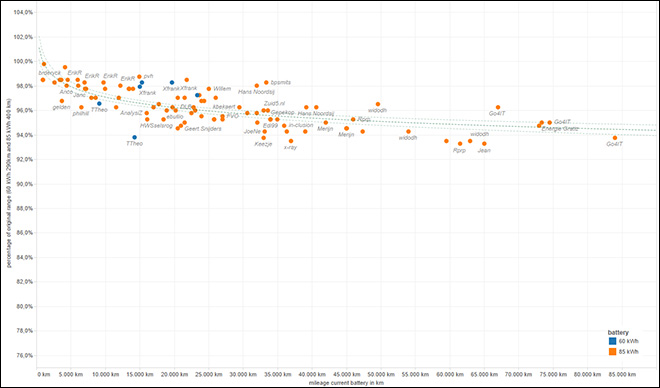Batteries do degrade over time, and unfortunately most EV models haven’t been on the road long enough to provide a lot of data, so there is still much to be learned about how quickly capacity loss takes place.
Plug In America has conducted battery longevity studies for the Nissan LEAF and Tesla Roadster, and is in the process of doing the same for the Model S.
RELATED: Tesla Roadster battery longevity exceeds projections
In the Netherlands, Tesla enthusiast Merijn Coumans is working on a parallel project, updating a file of owners’ data on a regular basis, via the Dutch-Belgium Tesla Forum.

In this figure, created by engineering professor Maarten Steinbuch, the percentage of range loss is shown on the vertical axis, with 85 kWh models in orange and 60 kWh models in blue. The horizontal axis displays the distances driven.
The collected data indicate that the rate of degradation starts out relatively fast, then slows down as more mileage is put on the car. After about 50,000 miles, the overall range degradation is about 6%. From that point onwards, range is lost at a rate of approximately 1% per 30,000 miles.
SEE ALSO: Tesla infinite-mile warranty will also apply to Models X and 3
However, Steinbuch notes that, “these equations are just for engineering ‘fun’: we have only a limited amount of data points, a limited max distance, and the individual capacity will depend also on (ambient) temperature, time, usage etc.”
Battery pack balancing will also effect the reported range estimation. If the cells are widely out of balance, the reported range could be lower independent of any cell degradation. One Model S driver reported a range increase of about 10 km after “several full charges combined with deep discharges,” which, theoretically, gives the cells an opportunity to be closely balanced.
“I agree [that balancing effects the range estimation],” said Steinbuch, “but it is the best we have, at least you could say that these numbers are a lower bound – i.e. the truth will always be better than these numbers!”
Source: Maarten Steinbuch
Image: hans-johnson/flickr
[Updated 2/4/15 11:30am EST to explain the limitations of this data.]

















































































